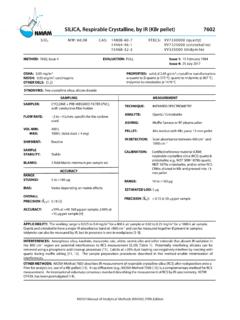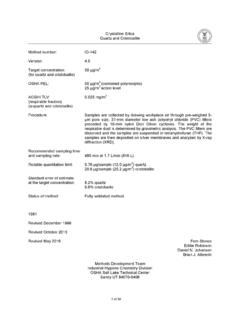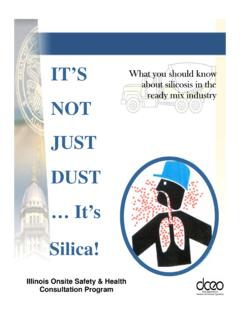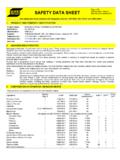Transcription of SILICA, CRYSTALLINE by IR 7602 - M. D. Campbell
1 silica , CRYSTALLINE by IR 7602 SiO2 MW: CAS:14808-60-7 ( quartz ) RTECS:VV7330000 ( quartz )14464-46-1 (cristobalite)VV7325000 (cristobalite)15468-32-3 (tridymite)VV335000 (tridymite)METHOD: 7602, Issue 2 EVALUATION:Issue 1: 15 February 1984 Issue 2: 15 August 1994 OSHA : quartz (respirable): 10 mg/m3/(% SiO2 + 2);cristobalite and tridymite (respirable): 1/2 the mg/m3; carcinogensACGIH: quartz (respirable) mg/m3cristobalite (respirable) mg/m3tridymite (respirable) mg/m3 PROPERTIES:solid; CRYSTALLINE transformations: quartz to tridymite @ 867 C; tridymite tocristobalite @ 1470 C; - quartz to - quartz @ 573 CSYNONYMS:free CRYSTALLINE silica ; silicon dioxideSAMPLINGSAMPLER:CYCLONE + FILTER(10-mm nylon, or Higgins-Dewell (HD) + m or 5- m PVC or MCE membrane)FLOW RATE:nylon L/minHD l/minVOL-MIN:400 L -MAX:800 LSHIPMENT:routineSAMPLE STABILITY:stableBLANKS:2 to 10 field blanks per setBULK SAMPLE:required; area respirable or settled dustMEASUREMENTTECHNIQUE:INFRARED ABSORPTIONSPECTROPHOTOMETRYANALYTE:quart zASH:muffle furnace or RF plasma asherPELLET:mix residue with KBr; press 13 mmpelletIR:scan absorbance from 1000 to 600 cm-1 CALIBRATION: quartz diluted in KBrRANGE:10 to 160 g quartzESTIMATED LOD:5 g quartzPRECISION (S r): < @ 30 g quartz per sample,in coal dust [1]ACCURACYRANGE STUDIED:not studiedBIAS:unknownOVERALL PRECISION (S rT):not determinedACCURACY:not determinedAPPLICABILITY: The working range is to mg/m3 for a 400-L air sample.
2 Cristobalite and tridymite also have majorabsorbance peaks at 800 cm-2 which can be used for their determination [1-6].INTERFERENCES: Amorphous silica , calcite, cristobalite, kaolinite and tridymite interfere; see METHODS: This is P&CAM 110 [1]. It is similar to Method 7603, except for sample preparation (KBr pellet ). CRYSTALLINE silica can also be determined by X-ray diffraction (Method 7500) and spectrophotometry (Method 7601).XRD can distinguish the three polymorphs and does not detect amorphous silica . Silicates, which interfere with XRD, are removedby phosphoric acid Manual of Analytical Methods (NMAM), Fourth Edition, 8/15/94 silica , CRYSTALLINE by IR: METHOD 7602, Issue 2, dated 15 August 1994 - Page 2 of 5 * (NIST SRMs # 1878 and 2679,Standard Reference Materials Program, Rm204, Bldg. 202, National Institute of Standardsand Technology, Gaithersburg, MD 20899).
3 Bromide (KBr), infrared , 95% for cleaning sample handlingequipment.* acid, 9% w/w. Dilute 25 mLconc. HCl (37% w/w) to 100 mL withdeionized stock standard, weigh and thoroughly mix 5 g KBr(dried overnight at 110 C) with 25 mg in a bottle in a desiccator.*See SPECIAL : : 37-mm diameter, m pore size,polyvinyl chloride filter supported withbackup pad in a two-piece, 37-mmcassette filter holder (preferably,conductive) held together by tape orcellulose shrink : 10-mm nylon or Higgins-Dewell(HD), or head holder: Holder must keepthe cassette, cyclone and coupler togetherrigidly so that air enters only at thecyclone inlet. air sampler: PVC membrane filter, 37-mm, 5- m pore size in two piece filtercassette. Sample closed-face at 3 L/min. pumps for HD cyclone, L/min;nylon cyclone, L/min; and area sampler, 3L/min.
4 Spectrophotometer; laboratory pressfor preparing KBr pellets; 13-mm KBr pelletdie (evacuable). (RF Plasma) asher andaluminum weighing pans or muffle furnaceand porcelain crucibles. and pestle, 50 mm agate or mullitemetal microspatula; non-serrate, non-magneticforceps; desiccator, camel's hair brush,glassine paper. balance ( mg) for preparingstandards. filtration apparatus, PRECAUTIONS: Avoid inhaling silica dust [1].Ethanol is flammable. Keep away from each personal sampling pump with a representative sampler in at 5% L/min with nylon cyclone or 5% with HD cyclone for a total samplesize of 400 to 800 L. Do not exceed 2 mg total dust loading on the :Do not allow the sampler assembly to be inverted at any time when using a cyclone. Turning the cyclone to anything more than a horizontal orientation may depositoversized material from the cyclone body onto the one of the following methods to ash samples and temperature (RF Plasma) asher: Place the filters in labelled aluminum dishes(previously rinsed with distilled water, followed by ethanol, and air dried).
5 Place the dishesNIOSH Manual of Analytical Methods (NMAM), Fourth Edition, 8/15/94 silica , CRYSTALLINE by IR: METHOD 7602, Issue 2, dated 15 August 1994 - Page 3 of 5in the low temperature asher so that sample exposure to the plasma is optimized. Ashaccording to manufacturer's instructions. Carefully bring asher to atmospheric pressure andremove the furnace: For samples containing a significant amount of calcite (> 20% of the totaldust loading), wash filters with 9% w/w hydrochloric aicd. Other samples proceed to a m, 47-mm PVC filter in the filtration apparatus. Remove sample filter fromcassette and center on top of first filter. Clamp funnel over the frit so that dust depositis completely exposed. Add 10 mL 9% w/w HCl and 5 mL 2-propanol; allow to stand 5min. Apply vacuum and slowly aspirate the acid and alcohol in the funnel. Wash withthree successive 10-mL portions of distilled water.
6 Release filter samples and blanks in porcelain crucibles, loosely cover, and ash in mufflefurnace for 2 h at 600 C (800 C if graphite is present). approximately 300 mg KBr, weighed to mg and dried overnight at 110 C, directly toeach sample. Mix the sample ash and KBr thoroughly with a pestle. Transfer to mortar tocomplete mixing if necessary. Transfer the mixture to a 13-mm evacuable pellet die usingglassine paper and camel's hair brush. Press a pellet using standard technique. Weight thefinished pellet to mg. Calculate the ratio (weight of finished pellet/weight KBr initially added);it is usually about Clean sample handling equipment with ethanol between :A low relative humidity environment will facilitate sample handling when using AND QUALITY working standard , to mg, portions of calibration stock standard containing 10 to 200 g an accurately-weighed 300 mg KBr.
7 Proceed as in step the ratio (weight of finished pellet/weight of solids added); usually about the absorbance at 800 cm-1 for each standard pellet following the analyticalprocedure (step 8). Plot absorbances vs. g samples were low temperature ashed (step ) and kaolinite is present, prepare pelletscontaining 100 to 600 g kaolinite. Determine the absorbance at 800 cm-1 and at 915 cm-1 asabscissa. Prepare at least five different kaolinite concentrations. Use this curve to correct theabsorbance value at 800 cm-1 for any sample containing media blanks and filters spiked with known amounts of quartz through the samplepreparation procedures (steps 3 and 4) to monitor for contamination and the infrared spectrophotometer to absorbance mode and to the appropriate settings forquantitative analysis. Scan the pellet from 1000 cm-1 to 600 cm-1. Rotate the pellet 45 andscan this diameter.
8 Repeat twice more until 4 scans have been obtained. If the peak at 800cm-1 is small, use 5X ordinate expansion to enhance the peak height. Draw an appropriatebaseline under the absorbance band at 800 cm-1 from approximately 820 to 670 cm-1. Measurethe absorbance at 800 cm-1 from maximum to baseline in absorbance units. Average the fourvalues for each the sample was ashed at low temperature (step ), the presence of kaolinite will beindicated by an absorption band with a maximum at 915 cm-1. Draw an appropriate baselineunder this band from approximately 960 to 860 cm-1 and measure the absorbance at 915 cm-1from this baseline to the Manual of Analytical Methods (NMAM), Fourth Edition, 8/15/94 silica , CRYSTALLINE by IR: METHOD 7602, Issue 2, dated 15 August 1994 - Page 4 of 5 for kaolinite. Determine the sample absorbance at 915 cm-1 (step 9), refer to thekaolinite curve (step 6) to find the absorbance at 800 cm-1.
9 Use this corrected value in step correction for kaolinite is not required, use the absorbance at 800 cm-1 to find the weight ofquartz, Wq ( g), from the calibration the concentration of silica , C (mg/m3), in the volume of air sampled, V (L) percent quartz , % Q, is required, divide the weight of quartz , Wq ( g), by the total sampleweight, Ws ( g):EVALUATION OF METHOD:This method is based on the well-characterized infrared method [1]. This method is particle sizedependent. A mismatch of standards and sample particle sizes will result in an uncorrectable bias. Athorough study of the range of biases in IR methods has not been :[1]NIOSH Manual of Analytical Methods, 2nd. ed., V. 1, P&CAM 110, Department of Health,Education, and Welfare, Publ. (NIOSH) 77-157-A (1977).[2]Talvitie, Determination of quartz in the Presence of Silicates Using Phosphoric Acid, , 23, 623-626 (1951).[3]Larsen, , von Loenhoff and Crable.
10 The Quantitative Determination of quartz inCoal Dust by Infrared Spectroscopy, Am. Ind. Hyg. Assoc. J., 33; 367-372 (1972).[4]Dodgson, J. and W. Whittaker. The Determination of quartz in Respirable Dust Samples byInfrared Spectrophotometry-1: The Potassium Bromide Disc Method, Ann. Occup. Hyg., 16;373-387 (1973).[5]Cares, , Goldin, Lynch and Burgess. The Determination of quartz inAirborne Respirable Granite Dust by Infrared Spectrophotometry, Am. Ind. Hyg. Assoc. J., 34;298-305 (1973).[6]Taylor, , Nenadic and Crable. Infrared Spectra for Mineral Identification, Am. Assoc. J., 31, 100-108 (1970).[7]Criteria for a Recommended Exposure to CRYSTALLINE silica , of Health, Education, and Welfare, Publ. (NIOSH) 75-120 (1974).METHOD REVISED BY: Charles Lorberau, Manual of Analytical Methods (NMAM), Fourth Edition, 8/15/94 silica , CRYSTALLINE by IR: METHOD 7602, Issue 2, dated 15 August 1994 - Page 5 of 5 APPENDIX:INTERFERENCESQ uartz and cristobalite can be determined in each other's presence by the use of less sensitive bands at695 cm-1 ( quartz ) and 625 cm-1 (cristobalite).








